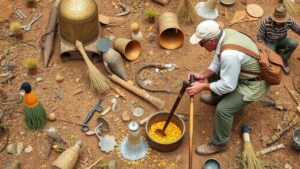Detecting for Relics Along River Bluff Trails and Picnic Areas
Detecting for Relics Along River Bluff Trails and Picnic Areas
Relic hunting, the practice of searching for historical artifacts, has gained popularity among enthusiasts and academics alike. The diverse environments of river bluff trails and picnic areas offer unique opportunities for such explorations. This article aims to provide a comprehensive guide to detecting for relics in these regions, discussing methodologies, tools, and the significance of findings.
Understanding the Environment
River bluff trails and picnic areas serve as both recreational spaces and historic sites. e locations are shaped by natural erosion, historic human activities, and socio-environmental factors, making them ideal for locating relics.
Bluffs near rivers can expose layers of soil that have accumulated over centuries, potentially containing items from various historical periods. Picnic areas, often frequented by people, may have discarded items, adding to the potential finds.
- River bluff trails may show signs of historical use, such as old paths or settlement remnants.
- Picnic areas can reveal modern and older artifacts through user activity.
Tools and Techniques for Detection
Effective detecting requires the right tools and techniques. Here, we explore common equipment and methodologies to enhance relic hunting efforts.
Metal Detectors
Metal detectors are the quintessential tool for relic hunting. Depending on the location and expected finds, various detectors can be utilized:
- VLF (Very Low Frequency) detectors, ideal for shallow searches and relics.
- PI (Pulse Induction) detectors, effective for deep targets in mineralized soil.
For example, using a VLF detector in a picnic area may yield a range of metal items from bottle caps to historical coins, while a PI detector may be beneficial along river banks for locating deeper submerged items.
Digging Tools and Safety Gear
Digging tools are essential for recovering relics without damaging them. Common tools include:
- Trowels for shallow digging
- Shovels for deeper excavation
- Pinpointers to precisely locate metal targets
Safety gear, such as gloves and knee pads, can also protect the detectorist while working in rugged terrain.
Legal Considerations and Ethical Hunting
Before embarking on relic hunting, understanding legal regulations is crucial. Different regions have specific laws governing the recovery of historical artifacts to protect cultural heritage.
- In many places, a permit may be required for metal detecting on public lands.
- Private property necessitates landowner permission.
Ethical considerations, such as “leaving the site as you found it†and accurately reporting significant finds, should also guide the hunting process. Engaging with local historical societies can enhance this relationship with the community.
Case Studies of Successful Finds
Examining case studies provides insight into the potential rewards of relic hunting along river bluff trails and picnic areas. One notable instance involved a group of enthusiasts who discovered a cache of Civil War-era coins along a riverbank. This finding garnered considerable attention, not solely for its monetary value but also for its historical significance, prompting further archeological exploration in the area.
Another case involved the recovery of Native American artifacts in a picnic area, which led to a partnership between the local tribe and the detectorist community. Together, they organized a preservation program to protect the site and educate the public about its historical context.
Practical Takeaways for Relic Hunters
Successfully detecting relics along river bluff trails and picnic areas requires a combination of knowledge, preparation, and respect for the environment and regulations. Here are some practical takeaways:
- Research the area’s history to identify potential finds.
- Invest in quality metal detection tools appropriate for your target type.
- Always comply with legal and ethical guidelines to maintain the integrity of your activities.
- Join local metal detecting clubs or associations for improved learning opportunities and community support.
By embracing these practices, relic hunters can enjoy both the thrill of discovery and contribute to preserving historical narratives for future generations.



